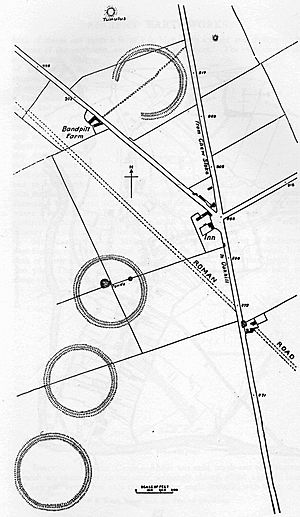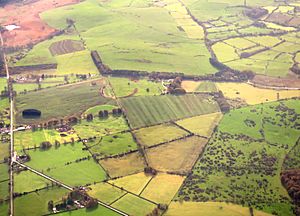Priddy Circles facts for kids
 |
|
| Location | near Priddy and Wells |
|---|---|
| Region | Somerset, England |
| Coordinates | 51°16′20.93″N 2°39′38.85″W / 51.2724806°N 2.6607917°W |
| Type | Earthwork enclosures |
| History | |
| Periods | Neolithic |
| Site notes | |
| Condition | ruined |
The Priddy Circles are a set of four large, round shapes made from earth near the village of Priddy in Somerset, England. These circles are ancient earthwork enclosures. They are found on the Mendip Hills.
Experts believe these circles were built during the Neolithic period, which was a very long time ago. They might have been used for special ceremonies or rituals. Today, the Priddy Circles are protected as Scheduled Ancient Monuments. This means they are important historical sites that must be preserved.
Contents
What are the Priddy Circles?
The four circles are arranged in a line, stretching for about 1.2 kilometers (0.75 miles). Each circle is very large, measuring between 185 and 194 meters (about 600 to 640 feet) across. Three of the circles are close together. The fourth one is about 350 meters (1,150 feet) to the north and slightly out of line.
There isn't a missing circle in the space between the northernmost circle and the others. A modern road (the B3135) and an old Roman road cross through this gap.
How the Circles Were Built
Each of the four circles has a flat area in the middle. This area is surrounded by a raised bank and a ditch on the outside. They also have more than one entrance.
Between 1956 and 1959, a group from the University of Bristol Spelæological Society dug into the circles. They found that the banks had cores made of stone. There were also holes for posts and stakes on either side. This suggests how the banks were built.
Scientists have used special tools to study the circles further. Geophysical surveys in 1995 and a magnetometer survey in 2006 helped them learn more about what is hidden underground.

Details of Each Circle
The circles are numbered from 1 to 4, starting with the one furthest south.
- Circle 1: This is the most southerly circle. It is 194 meters (636 feet) across. Its ditch is still visible, up to 6 meters (20 feet) wide and 1.2 meters (4 feet) deep. It has several gaps, but one to the north-north-east was likely an original entrance.
- Circle 2: This circle is 185 meters (607 feet) in diameter. Its bank is up to 6 meters (20 feet) wide and 1 meter (3 feet) high. The ditch is about 0.5 meters (1.6 feet) deep. There are three gaps, and one to the north-north-east might be an original entrance. Inside Circle 2, there is a possible oval-shaped mound, perhaps an ancient burial site, measuring 14 by 9 meters (46 by 30 feet).
- Circle 3: This circle is up to 190 meters (623 feet) across. It has a bank up to 1 meter (3 feet) high and 7 meters (23 feet) wide. The ditch is up to 1 meter (3 feet) deep and 5 meters (16 feet) wide. There are four gaps. One to the south-south-west is thought to be an original entrance because it lines up with an entrance of Circle 2.
- Circle 4: This circle is also up to 190 meters (623 feet) in diameter. However, only about two-thirds of this earthwork is still present. Studies in the 1950s suggested that the missing western part was never finished. This might have been due to the ground sinking in that area. Near Circle 4, there are also some mounds that are believed to be ancient burial sites.
Protecting Ancient Sites
In 2011, some damage was reported at the southernmost Priddy Circle. This site is very old and important, so it needs to be protected.
The damage happened when workers brought in materials and used machinery. This caused ruts in the ground and harmed parts of the ancient ditch. Some natural holes in the ground, called "swallet holes," were also filled with rubble. These holes might have been important to how the monument was first built.
English Heritage, an organization that protects historic places, investigated the damage. They said that a "really, really rare piece of Neolithic engineering had been lost forever" because of the harm to the site. It is very important to get permission and advice from experts like English Heritage before doing any work near ancient monuments. This helps make sure these special places are preserved for everyone to learn from in the future.
Images for kids



